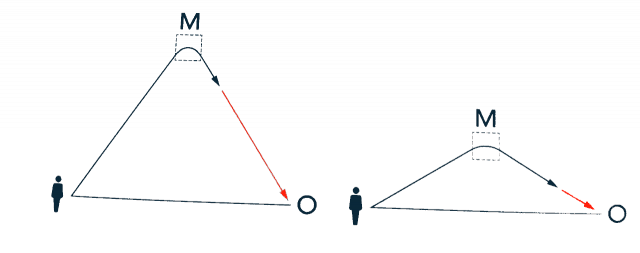
Minding the gap / resolving the gap
Vygotsky: considers human perception as a triangular relation between Subject, Object and the cultural Medium the subject belongs to.
- Subject to Object = direct experience (shape, color, smell, etc.)
- Subject through Medium to Object = indirect experience, mediated by feelings, memories, cultural/social context
Both ways of connecting with the Object occur in parallel. The object can be more or less familiar to our cultural frame. The more unfamiliar, the wider the gap. The imagination is called upon to fill in the difference. Unfamiliar objects, events become more familiar over time. Objects and places develop patinas of meaning.
The imagination is used to close the gap, figuring out how to fit the novel into the known. In reasoning this happens in different ways:
- deductive: small gap, closed easily & quickly
- inductive: not all facts are know, the gap is wider. Might need analogy and metaphor to find ways to explain the novel/unknown.
- abductive: critical pieces are missing. The gap is too wide to to close directly: we need to start to speculate. Instead of directly closing the gap, multiple options need to be generated to work on the space of the gap.
At the far edge of abductive reasoning, into speculation, the imagination shifts from sense-making to sense-breaking. The gap is widened first with multiple ideas, scenarios, hypotheses. Then, together with reasoning, these are worked upon to close the gap, assimilating the novelty into the known.
Pragmatic Imagination: imagination put to purpose
(The book changes pace here, outlining principles 3 to 6 in quick succession).
So, again: the imagination powers a whole range of cognitive processes. From know to novel, from sense-making to sense-breaking. Especially the poïetic part of the spectrum is needed to work on the challgens of a rapidly changing and interrelated world. (poiesis: the activity in which a person brings something into being that did not exist before).
Making the imagination pragmatic means:
The actual must be seen in light of meaningful, purposeful possibilities and opportunities
Any event one experiences can be interrogated in terms of what it means and what other events, or relationships, it might lead to, what possibilities it might open up.
Thought and action are indivisible and reciprocal.
Thought and action for meaningful anticipation of the world. Thought and action for turning ideas into action.
The imagination must be instrumentalized to turn ideas into action
To move from “anticipating the world” to “turning ideas into action” requires envisioning and scaffolding of unfolding action, the imagination must be instrumentalized.
Because the imagiation is not under conscious control, we need to understand, find and design ways to set it in motion and scaffold it throughout meaningful activity.
We need new tools for setting the imagination in motion, scaffold its emergence and then instrumentalizing its products to accomplish real world things.
Setting the imagination in motion
Ways to overcome the fear of the blank canvas and trick the free play imagination into action.
- The Surrealists invented methods to spark the imagination: cadavre exquis, nonsense, automatic writing, free association, etc.
- Introducing chance as an agent for coming up with new ideas
- Drugs
- The derivé, an urban “drifting” invented by The Situationists.
- Evocative objects and precedents